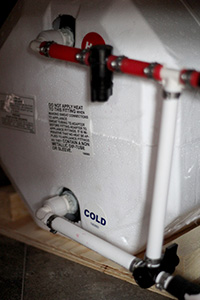How to Winterize Your RV
The basics of winterizing an RV are about caring for the battery and emptying the water out of the plumbing system, with the option to blow out the lines or refill them with non-toxic antifreeze.
Batteries
A battery will lose its charge through non-use and if it sits partially charged it will lose its full power-generating ability. Cold will slow down the process and being connected to a possible power drain will speed it up.
To preserve the battery over winter, we recommend that you:
- Make sure to charge the battery to a full charge
A charged battery should survive the freezing temperatures with minimal effect.
- Disconnect the battery or remove it from the RV and store it in a cool place
- Monitor the charge throughout the winter season
Plumbing
The winterizing process starts with emptying all of the holding tanks:
- Fresh water
- Grey water
- Black water
To empty the holding tanks:

- Open the main fresh water supply drain mounted on the outside of the RV and let the water flow until the fresh water tank is empty
- Dump the black water tank
The black water tank is done before the grey because water in the grey tank helps flush solids and septic residue in the flexible hose line.
- Dump the grey tank
- Rinse out both tanks with fresh water before returning the hose to its storage compartment
The next step is to empty the water heater tank:
- Open the drain plug or petcock drain valve on the RV's exterior
- Open the water heater hatch and drain the tank - remove the screw-in plug or opening of the valve found near the bottom of the tank

Once the tanks are drained, you must either remove any remaining water in the lines or add RV-rated antifreeze to prevent any remaining water from freezing.
To blow dry the lines:
Open all the taps
Including the toilet flushing device and the shower head spray
Use compressed air to the city water external hose connection using a blow out plug
Apply air until the air is almost dry coming from all the open taps
Blowing out the lines does not guarantee the removal of all of the water. Failure to drain the water completely, prior to freezing weather can result in extensive damage to the water lines, holding tanks, water heater and pumps.
The option to blowing the lines dry is to add non-toxic, RV antifreeze
Automotive antifreeze should NOT be used in the drinking water system as it is poisonous!
To fill the lines with non-toxic, RV antifreeze:

- Close the water heater tank drain
- Engage the bypass on the hot water tank
Bypass kits can be purchased at your local RV parts supply store
- Remove the suction end off the water pump
- Attach a length of clear vinyl tubing and put the hose directly into the jug of antifreeze
- Open all taps one at a time
Including the inside and outside showers
- Turn on the water pump and let run until all the taps are running with pink fluid
- Add one or two cups of the antifreeze to the P-traps
If your RV has water based appliances such as icemakers and washing machines, we recommend you have it winterized by a service facility.
Not a D.I.Y. guy/gal?
$59.95 - $89.95 plus antifreeze
